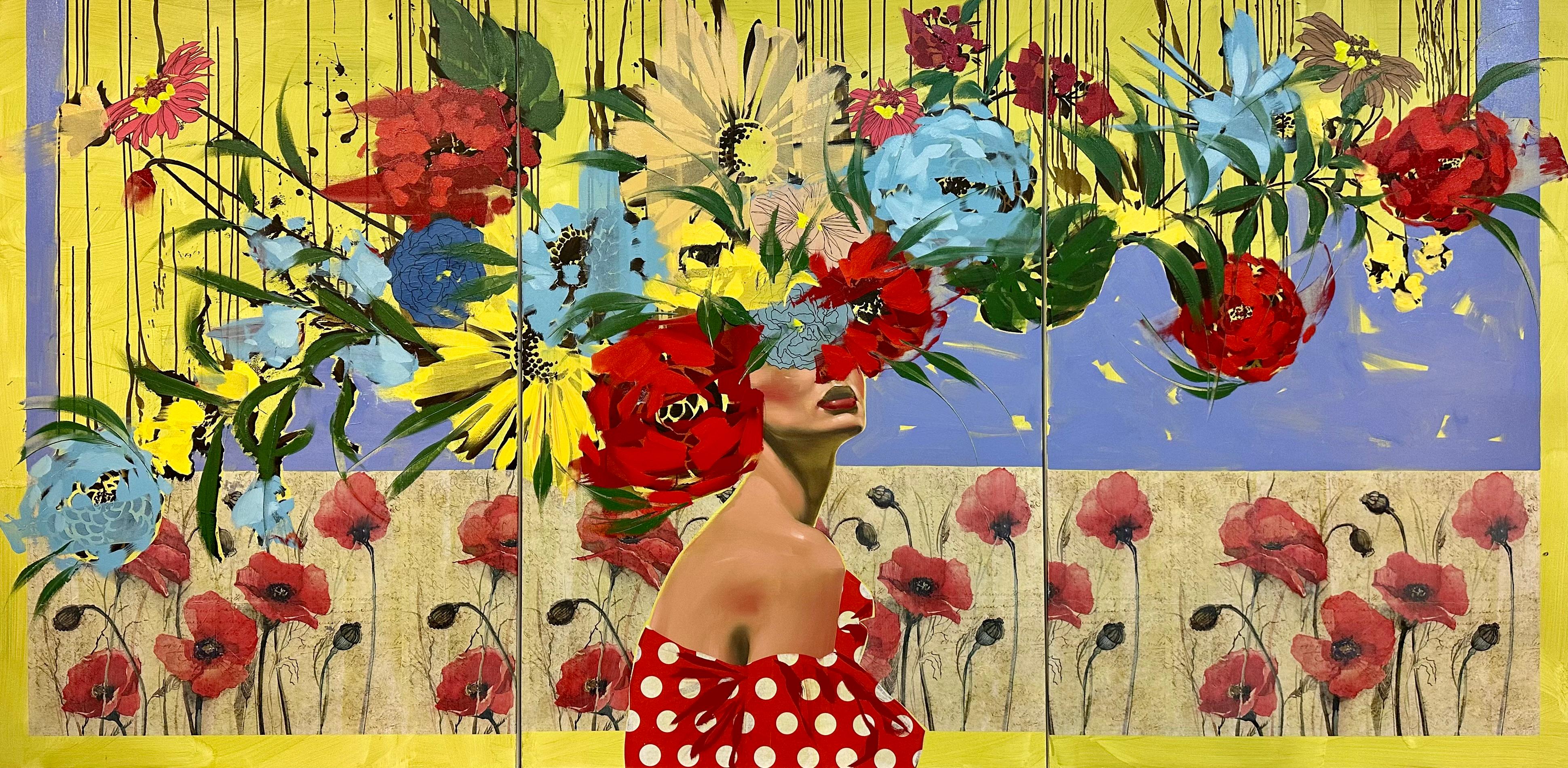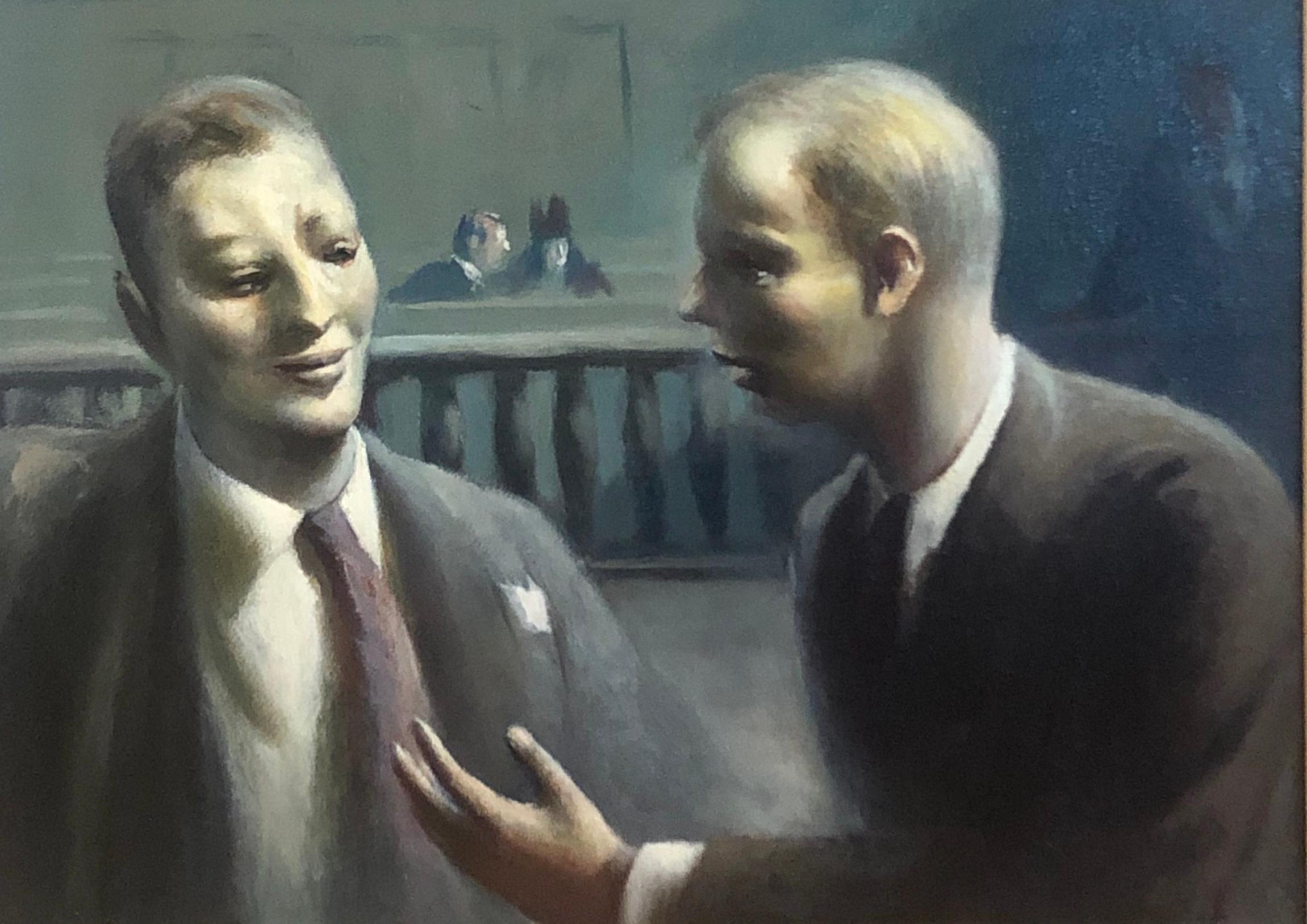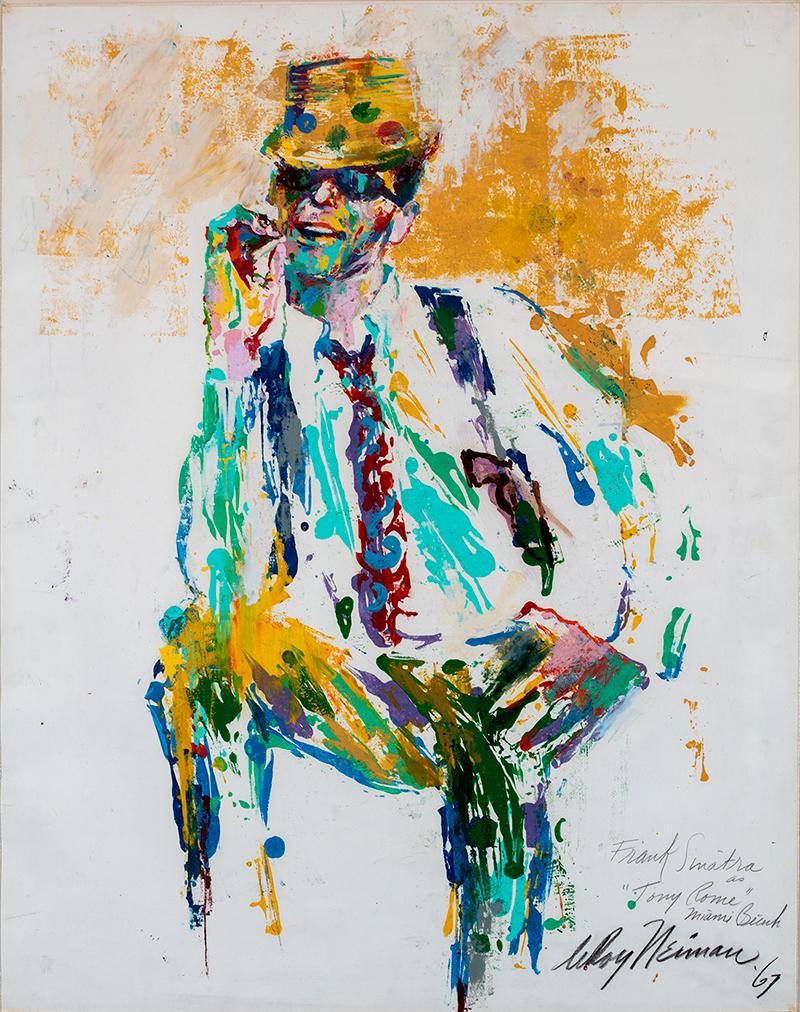Items Similar to Machiel Hopman (1928–2001), Portrait of an African woman, oil on paper
Want more images or videos?
Request additional images or videos from the seller
Machiel HopmanMachiel Hopman (1928–2001), Portrait of an African woman, oil on paper
About the Item
Machiel Hopman (1928–2001)
Portrait of an African woman
Signed bottom right Nzama (pseudonym)
Oil on paper
Dimensions: approx. 39 x 32 cm. (excl. passe-partout and frame)
In his native city of The Hague, he studied at the Academy of Fine Arts and immediately left for Paris for a year. In 1954 he embarked on a boat to South Africa, where he 'created abstract compositions with an explosive use of colour' and opened his own gallery, the Hopman Gallery in Johannesburg. He also invites black artists to exhibit there, which was very unusual in the apartheid era. Inspired by the proud, mystical culture of the population, he makes paintings under the name Nzama, which are very successful in America and the Netherlands. He also depicts reality on large canvases, but no matter how gray and sad he depicts the impoverished townships, there is always a glimmer of hope for a better future, for example through a bright spot in a dark cloudy sky. He paints everything, including the abstract compositions painted in warm, lighter colours, with his heart, and you can see and feel it.
In order to avoid the apartheid atmosphere, he leaves for the Netherlands in 1973 with his wife and children. In the mid-nineties, however, he returns to his favorite country, where the mix of space, freedom, warmth and scenic beauty grabs him again. He paints with passion in an unprecedented color intensity. Even when his health leaves much to be desired and a medical examination reveals cancer, he continues to paint. Until his death in 2001. Machiel Hopman still knows how to convince and move us with the great expressiveness of his work. (Bureaulakenvelder)
- Creator:Machiel Hopman (1928 - 2001, Dutch)
- Dimensions:Height: 15.36 in (39 cm)Width: 12.6 in (32 cm)Depth: 0.79 in (2 cm)
- More Editions & Sizes:39 x 32 cm.Price: $661
- Medium:
- Period:
- Condition:
- Gallery Location:DEVENTER, NL
- Reference Number:1stDibs: LU2366212880912
About the Seller
5.0
Vetted Seller
These experienced sellers undergo a comprehensive evaluation by our team of in-house experts.
Established in 2015
1stDibs seller since 2023
7 sales on 1stDibs
- ShippingRetrieving quote...Ships From: DEVENTER, Netherlands
- Return PolicyA return for this item may be initiated within 7 days of delivery.
More From This SellerView All
- Oil painting of Dutch town Deventer, The mint, J. A. van Schooten (1870-1933)By Jan Antonius van SchootenLocated in DEVENTER, NLJ. A. van Schooten (1870-1933) 'The mint, Deventer' Signed lower left J. v. Schooten Maroufle (oil on canvas on board) Dimensions without frame: 26 x 34 cm. Dimensions with frame: 4...Category
Early 20th Century Figurative Paintings
MaterialsBoard, Canvas, Oil
- Antique Dutch oil painting on panel, traveler horseback with a dog, ca. 1835Located in DEVENTER, NLPainting with a traveler on a white horse and accompanied by a dog looking up at a road sign in the form of a cross. On the roadsign is ” Arnhem”. (a town at the Rhine river in the E...Category
1830s Romantic Figurative Paintings
MaterialsWood Panel, Oil
- Madonna and child, Italian school, 18th centuryLocated in DEVENTER, NLItalian School, 18th century Depicted are the Madonna and Child Jesus, the virgin Mary is holding the Child Jesus lovingly in her arms. The child, lying on a bundle of cloth and with...Category
18th Century Figurative Paintings
MaterialsCanvas, Oil
- Tavern scene with drunken peasants enjoying dancing and drinking, after TeniersBy David Teniers the YoungerLocated in DEVENTER, NLCharming tavern scene depicting drunken peasants enjoying dancing and drinking in front a farmhouse/ tavern in a landscape. Painted in great detail in vivid colors on a hand cut oak ...Category
18th Century Figurative Paintings
MaterialsOil, Wood Panel
- Summery terrace scene by the German paintres Gabrielle Daube from HamburgLocated in DEVENTER, NLCharming summery terrace scene dominated by an elegant lady with a white hat and green gloves, next to her a suitor drinking wine and smoking a cigarette. At the table another elegant lady with red hair. A waiter and a man on a neighboring table look on how the romance will unfold. A blue- turquoise and white sun screen...Category
1920s Impressionist Figurative Paintings
MaterialsOil, Canvas
- Decorative antique oil painting on canvas, interior with lady playing the pianoLocated in DEVENTER, NLDecorative antique oil painting on canvas depicting a lady playing the piano in an interior Signed lower right Ft. B vd M Oil on canvas Dimensions excl. frame: approx. 51 x 48 cm. ...Category
Early 20th Century Interior Paintings
MaterialsOil, Canvas
You May Also Like
- Figurative/Female/Portrait/Floral_Sounds of Summer (Diptych)_Anna Kincaide, 2024By Anna KincaideLocated in 326 N Coast Hwy. | Laguna Beach, CAANNA KINCAIDE "Sounds of Summer (Diptych)" Oil & Mixed Media on Canvas 60 x 120 inches Communicating emotion and narrative with limited assistance from her figure’s facial expressio...Category
2010s Contemporary Figurative Paintings
MaterialsCanvas, Paper, Oil
- Figurative/Female/Portrait/Floral_Wonder With Me (Triptych)_Anna Kincaide, 2024By Anna KincaideLocated in 326 N Coast Hwy. | Laguna Beach, CAANNA KINCAIDE "Wonder With Me (Triptych)" Oil & Mixed Media on Canvas 60 x 120 inches Communicating emotion and narrative with limited assistance from her figure’s facial expression...Category
2010s Contemporary Figurative Paintings
MaterialsCanvas, Paper, Oil
- Guy Pene du Bois WPA American Modernism Realism NYC Scene Oil Lawyers in CourtBy Guy Pène Du BoisLocated in New York, NYGuy Pene du Bois' "Two Figures in Courtroom" is a WPA era American scene oil painting created in a realistic style. Modernism at its best The work is framed by Heydenryk. Pène du Bois descended from French immigrants who settled in Louisiana in 1738 and was raised in a Creole household. He was born in 1884 in Brooklyn, NY and first studied with William Merritt Chase at the New York School of Art and later continued his training with Robert Henri. Pène du Bois was greatly impressed with Henri's credo that "real life" was subject matter for art and throughout his life a realist philosophy informed his art as well as his parallel career, art criticism. In 1905, Pène du Bois made his first visit to Paris where he painted scenes of fashionable people in cafes rendered in the dark tonalities and impasto associated with the Ashcan School. By 1920, he had achieved his mature style, which was characterized by stylized, rounded, almost sculptural figures painted with invisible brushstrokes. The subjects of his paintings were often members of society whom he gently satirized. In 1924, Pène du Bois and his wife, Floy, left for France where they would remain until 1930. Returning to America showcases pictures the artist produced after this very productive period abroad. After five years of living in France, Pène du Bois was able to observe American life with fresh eyes. His work becomes more psychologically intense and less satirical. In Girl at Table a slender, blond is shown gazing at a small statue that she holds at arm's distance. The meaning is elusive, but a powerful sense of longing is evoked. Similarly, paintings such as Dramatic Moment and Jane are taut with unresolved dialogue. Both pictures depict mysterious interiors in which a lone woman anxiously awaits the denouement of a suspenseful scene. Other pictures, for example, Chess Tables, Washington Square and Bar, New Orleans, recall Pene du Bois's Ashcan origins in their depiction of urban entertainment. During this period, landscape becomes an important subject for Pène du Bois. Girl Sketching...Category
1930s American Modern Figurative Paintings
MaterialsPaper, Oil, Board
- "Frank Sinatra as Tony Rome"By LeRoy NeimanLocated in Lambertville, NJJim's of Lambertville Fine Art Gallery is proud to present this piece by LeRoy Neiman (1921 – 2012). LeRoy Neiman was born in 1921 in St. Paul, Minnesota. He displayed a great talent for art at a young age, working as an illustrator for local grocery stores as a teenager. Even after being drafted into the Army in 1942, he spent his spare time painting murals on the walls of kitchens and mess halls, where he served as a cook. Once the Army’s Special Services Division took notice of his talents, he was sent to work on painting stage sets for Red Cross shows in Germany after the war. Upon returning to the United States, Neiman enrolled briefly at the St. Paul School of Art before attending the School of the Art Institute of Chicago and later, teaching figure drawing and fashion illustration there. While working at the Art Institute of Chicago, Neiman discovered his primary medium, enamel house paint, when a janitor threw out some half-empty cans of it next door to his apartment. From this medium, he embraced a technique of rapid paint application. While freelancing as an illustrator for the Chicago department store, Carson Pirie Scott, in the 1950s, Neiman met Hugh Hefner, who would become a great friend and help establish his artistic reputation. In 1954, Hefner showed Neiman’s paintings to Playboy’s Art...Category
Mid-20th Century Figurative Paintings
MaterialsPaper, Oil
- The WarningLocated in Saratoga Springs, NYEdward Lamson Henry (American, (1841 - 1919)) “The Warning” Grisaille on paper mounted on board, signed lower left ‘E L Henry’ (partially obscured by frame) ...Category
Late 19th Century Hudson River School Figurative Paintings
MaterialsBoard, Oil, Laid Paper
- Head of an AngelLocated in New York, NYProcaccini was born in Bologna, but his family moved to Milan when the artist was eleven years old. His artistic education was evidently familial— from his father Ercole and his elder brothers Camillo and Carlo Antonio, all painters—but his career began as a sculptor, and at an early age: his first known commission, a sculpted saint for the Duomo of Milan, came when he was only seventeen years old. Procaccini’s earliest documented painting, the Pietà for the Church of Santa Maria presso San Celso in Milan, was completed by 1604. By this time the artist had made the trip to Parma recorded by his biographers, where he studied Correggio, Mazzola Bedoli, and especially Parmigianino; reflections of their work are apparent throughout Procaccini's career. As Dr. Hugh Brigstocke has recently indicated, the present oil sketch is preparatory for the figure of the angel seen between the heads of the Virgin and St. Charles Borrommeo in Procaccini's altarpiece in the Church of Santa Afra in Brescia (ill. in Il Seicento Lombardo; Catalogo dei dipinti e delle sculture, exh. cat. Milan 1973, no. 98, pl. 113). As such it is the only known oil sketch of Procaccini's that can be directly connected with an extant altarpiece. The finished canvas, The Virgin and Child with Saints Charles Borrommeo and Latino with Angels, remains in the church for which it was painted; it is one of the most significant works of Procaccini's maturity and is generally dated after the artist's trip to Genoa in 1618. The Head of an Angel is an immediate study, no doubt taken from life, but one stylistically suffused with strong echoes of Correggio and Leonardo. Luigi Lanzi, writing of the completed altarpiece in 1796, specifically commented on Procaccini's indebtedness to Correggio (as well as the expressions of the angels) here: “Di Giulio Cesare...Category
17th Century Old Masters Figurative Paintings
MaterialsPaper, Canvas, Oil





